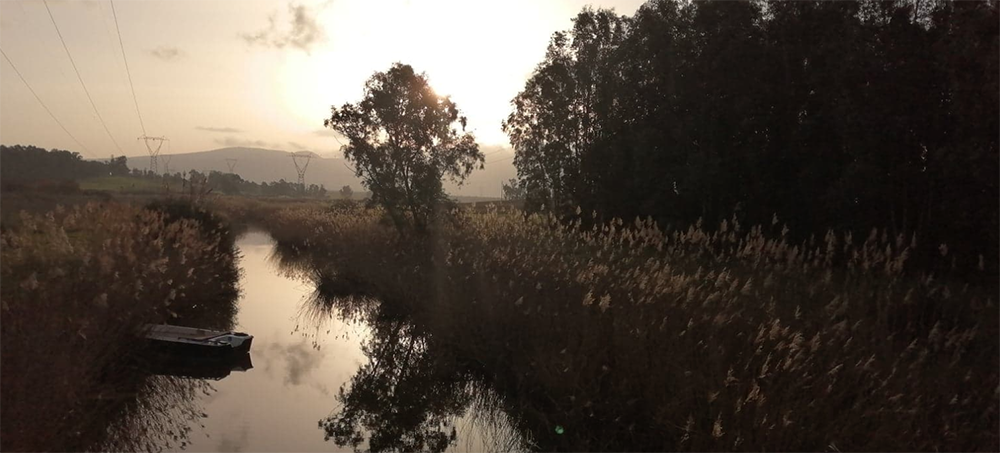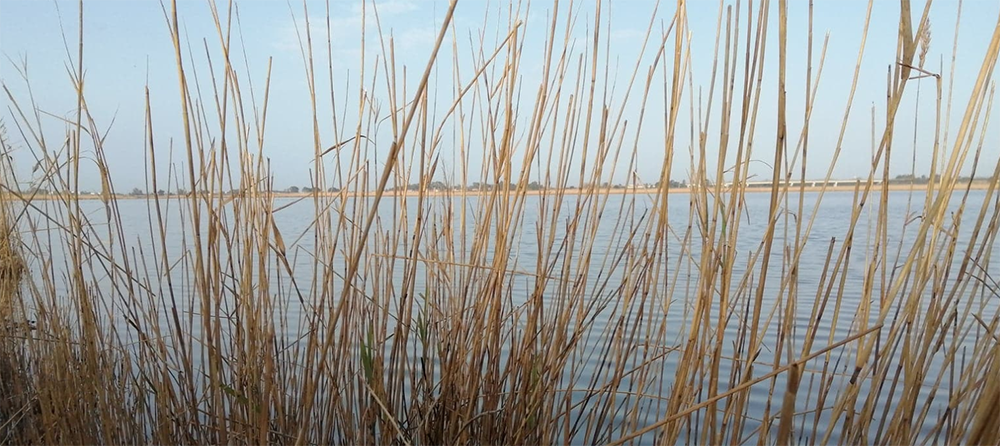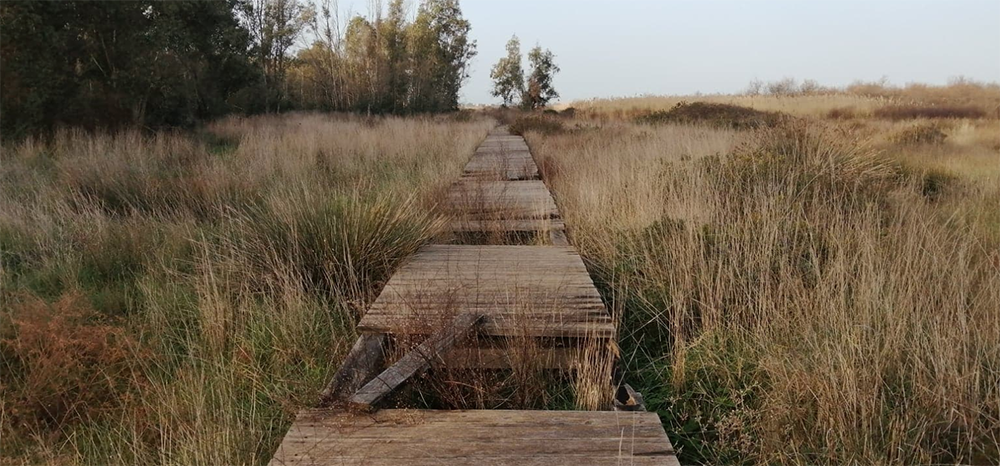The reeds glow in the golden light of the early morning. Around, the metallic gray of dawn still resists, ephemeral. A pool of water surrounds the slender trunk of a young tree, where the small ballast rises to become the path, cut in the furrows of the walkway by a long strip of grass. A flock of lapwings passes floating in its soft hesitations. “It had to face many bushfires. Fortunately, the flames do not affect the rhizomes, and the reed bed is able to rise again in a short period", says Walter Piras, Alea's environmental guide who accompanies us on a visit to Pauli Maiori's hidden treasure. Palmas Arborea has just turned into countryside. In the distance the muffled contrails of cars rise and die. The path is cool in the dew and the south-eastern wind that has swept the muddy earth for days has faded down into a breeze.
Low in the sky the brownish shape of a marsh harrier flies: “The reeds represent a vast and welcoming dormitory for many species. A perfect hunting space for the hawk. In the last census, dozens of specimens were identified. They come from central and northern Europe. Some couples are sedentary. Here, look, are two cormorants, and a water rail, there, on the left. A relative of the coot and moorhen. Rather elusive”, explains Piras, dropping the binoculars on his chest and showing on the guide a round and blue figure with a long red beak. On the right the mirror of a small light emerges. Pauli Maiori, in addition to being a Ramsar site, is also a Special Protection Area (SPA) and a Site of Community Interest (SIC). There is no risk of meeting carbines for the porciglione and the sultan chicken, which has found ideal conditions here to live and multiply. The pond is one of the most important areas in Europe for the friendly long-legged rail, with its red shield on the head and its many shades of blue.
The small arched wooden bridge that crosses the Merdegani stream is good news. Fires and floods have put a strain on the structures created for the usability of the pond with the 2006/2008 SIC management plan. The reeds run along the shore, multiplied on the water together with the clouds, a small wooden boat and the branches of a solitary eucalyptus, the vanguard of a forest along which what is left of the walkway stretches along. The scrub grows wild in an impression of greens, bronzes and yellows. A gray heron passes by with its relaxed and well-rounded flight. At dawn he has left the pond to visit the surrounding area, occupy the edges of fields and canals in search of small fish and amphibians.
The path is adventurous. The walkway is interrupted, it is torn off on one side, joined in its vacant spaces by a slat. Crows and lapwings pass by. The verse of the mallard arrives distinctly. “Pauli Maiori is an almost unchanged context. Birds are used to the presence of boats, the 'ciu' of S. Giusta fishermen, but not to cars and individuals on foot. Before fires and floods, the walkway ended with a tower from which it was possible to enjoy the spectacle. But besides this, the most appropriate way to enjoy the wonders of this pond is just on the water's surface", says Piras.
The dense vegetation ends on the edge of a plowed field, the border between the territory of Palmas Arborea and that of Santa Giusta. Then, just beyond the screen of the reeds, the pond opens up, placid and bright in the high sun. Piras reviews the guests resting on the blue mirror: the teals, the tufted duck, the pochards, the great crested grebe, the cormorants engaged in social fishing, orderly and efficient in alternating their heads like a team of cyclists in a race. And the seagulls, and the coots. From the center of the thick reed, every now and then a rustle turns into a flight: some wood pigeons, a female marsh harrier, yellow in the plumage of the head.
“The country has never had a particularly intense relationship with Pauli Maiori. In the past it has been used as a space for grazing or for gathering wood, rush and bunting, or 'zinnigas' as we call them here. A truck passed twice a week to buy the material that would serve the weaving craftsmanship, very common in the Oristano area", says Andrea Pisu Massa, mayor of Palmas Arborea. “A few years ago we experimented a short hiking circuit. A small pier welcomed boats coming from Santa Giusta, and with bicycles it was then possible to visit the whole area, also open to walkers with the walkway and the birdwatching turret. Then the flood of 2013 and the bushfires made the structures unusable. It would be important to reactivate the circuit, extending the routes also to horse riding, very lively in these parts. Of course, we would need specialized guides. The municipality would be happy to participate in the training of the new environmental escorts".

The Island made of mussels in Corru Mannu's pond began to be populated by birds
Little tern, common tern, sandwich tern, rosy gull and black-winged stilt are some of the bird species that have found a home in Corru Mannu in recent weeks. Thanks to…

Sardinian Wetlands, the best way to protect them is "to manage them"
Cagliari, 04.02.2023 – Le zone umide sono ecosistemi acquatici sempre più rilevanti, conoscerli meglio è il primo passo per tutelarli, ma non è tutto. “Serve uno strumento di gestione” per…

The II D from Terralba Institute visited the Old Tower of Marceddì as prize for Terre d'Acqua school contest 2022
Learning about the role of these precious and very important ecosystems, as well as the specificities of the large wetland area of Oristano. In recent days we have accompanied the…

Maristanis was showcased at the Ramsar COP 14 on wetlands during a side event
The 14th meeting of the Ramsar Wetlands Conference (COP14) was held in Geneva from 5 to 13 November 2022, simultaneously also in Wuhan, China. At the International Conference Center in Geneva (CICG) all…

Learning from the Maristanis's model in the ENSERES's visit exchange
Two days to study an integrated management model of marine-coastal systems, two days to strengthen ties and develop new strategies for a sustainable future of the Mediterranean. The Italian stage…

A step forward for the Maristanis project, towards the Regional Park of wetlands in Sardinia
The Municipal Council of Oristano, on the proposal of the Councilor for the Environment Maria Bonaria Zedda, has launched the participatory process and the preparatory actions necessary for the establishment…

Evaluating ecosystem services by the TESSA Methodology in Arborea
How to understand the effects on natural capitals and actual and potential state changes of individual sites important in promoting decisions to support both biodiversity conservation and ecosystem service provision?

Terre D'Acqua 2022, the winners of the school contest within the Maristanis Project
With 87 works, of which 84 in the drawing category and 3 in the comics category, the MEDSEA Foundation's Terre D’Acqua 2022 Competition ends. The school contest took place from February…

The Sardinian farms met in Arborea under the sign of Sustainability
This is the year of relaunch for the La Fiera dell’agricoltura di Arborea (Agricultural Fair of Arborea), one of the most important thematic fairs in Sardinia that promotes the productive, agro and…

Maristanis in the news: Rai and Italia 1 dedicated ample space to the Maristanis Project
The Italian press gave ample space to the Maristanis project in recent months, the Oristanese wetlands and its most important project Maristanis were told in various national and local television reports on…

The winner of the World Wetlands Day in Sardinia 2022 Contest
With a picture taken in the Oristanese lagoons representing a group of flamingos and the sentence "They come / They come back / Sometimes they stop / Like nomads /…

Over 700 visitors for the World Wetlands Day Calendar
Over 700 visitors in the World Wetlands Day collective calendar, put together by the MEDSEA Foundation, as part of the Maristanis project last February, with the aim of promoting the precious…

The World Wetlands Day 2022 in Sardinia lasts a month, the events Calendar
As every year, the World Wetlands Day on the anniversary of the RAMSAR convention (of 1971, Feb. 2nd) calls and Sardinia, in particular the Oristanese area, replies within the Maristanis project that…

World Wetlands Day in Sardinia, from 2 to 27 February join the competition #WWDSardegna on Instagram
In the occasion of the World Wetlands Day which celebrates ponds and lagoons in the world next February 2, the MEDSEA foundation launches the contest on wetlands in Sardinia with the hashtag #WWDSardegna to…

MAVA Steering Committee in Provence: Sardinia was promoted with the Maristanis project
MEDSEA foundation, which has been carrying out the Maristanis project in the Oristano area in Sardinia since 2017, attended last week the yearly meeting of the MAVA steering committee. The session took place from 16 to 17 December 2021 in Châteauneuf-le-Rouge, in the Provence-Alpes-Côte d'Azur region, and gathered together the…

Terre d'Acqua, a wetlands school competition for students in the Oristanese
On February 2, the World Wetlands Day will be celebrated once again the Oristanese wetlands region. To recall the central role of wetlands in addressing climate and environmental crisis and to raise awareness of the importance of these basins especially in this west coast side…
- 1
- 2
- 3
- 4



